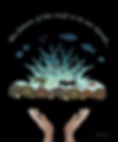Adi Khen, an Affiliated Artist of the Climate Science Alliance and PhD candidate at Scripps Institution of Oceanography, joins us on the blog for a guest post about the intersection of science and art!

Climate Science Alliance Affiliated Artist Adi Khen is a 5th-year PhD candidate in Dr. Jennifer Smith’s Lab at the Scripps Institution of Oceanography, UC San Diego. She joins us on the blog today for a guest post about the intersection of science and art!
I’m formally trained as a scientist, but self-taught as an artist. In developing my scientific skillset throughout graduate school and my artistic skillset in my spare time, I unexpectedly found myself at the intersection of science and art, within the field of scientific illustration. I now believe that scientific illustration can be used as a tool to communicate, educate, and motivate, and in this post I’ll be elaborating on why I think it’s important!
Biologist E.O. Wilson once said that “Science explains feeling, while Art transmits it,” which I interpret as: “science explains what happens in the world around us, while art communicates it.” In my mind, the functions of art in science range from depicting a scientific phenomenon, to teaching others about it more effectively, and finally, evoking feelings which ideally could help to motivate social change on a larger scale.
(1) Scientific illustration as a tool for communicating research Even the scientists among us will admit that science can be rather abstract and theoretical. Scientific concepts can’t always be captured in a photograph or described either verbally or in writing. Through art, we can highlight the more critical aspects and exclude the minor details in order to get our main point across; we also have the ability to show what would otherwise be microscopic, invisible, or unfathomable. As researchers, art is a valuable way for us to communicate science while avoiding excessive jargon and technicalities, thus making it easier to follow for a general audience.
(2) Scientific illustration as a tool for education We’ve all heard the saying, “A picture is worth a thousand words.” For non-scientists or young students, scientific ideas can often be better grasped through diagrams and other visuals. Art allows us to simplify the complicated systems that exist in nature and represent them in a more tangible way-- while still maintaining a level of accuracy that is based in reality. Given that each person processes new information differently, in some cases this can be more conducive to learning and promote memory retention. It can also make science more accessible to people who don’t have firsthand experience with it yet.
(3) Scientific illustration as a tool for motivating the general public Art is more commonly associated with emotion (subjectivity), while science appeals to logic (objectivity). In my opinion, scientific illustration pulls from each one and then merges the two into a finished product, which altogether can be more meaningful than just one or the other. A creative artistic perspective may grab people’s attention and engage their imagination, at which point science can come in with the underlying facts and have a stronger, long-lasting impact. Not only can this be used to foster people’s appreciation for nature and cultivate a deeper interest in science, but it can also inspire action against issues that the world is facing today, such as climate change.
As a scientist who studies the effects of climate change on coral reefs and, at the same time, as an artist who makes digital drawings of marine life... I think there’s something to be said about not just explaining the world scientifically or portraying it artistically, but straddling the line between them. Personally, I didn’t intend for scientific illustration to become part of my career, but one opportunity just led to the next. Overall, it’s been more satisfying than I could even try to express in words-- which is ironic, I guess, so I might as well keep drawing about it!
Please see some examples of my latest scientific illustrations below:

With the progression of climate change, coral reefs worldwide as becoming increasingly threatened. Coral reefs provide life, biodiversity, and many ecological goods and services; as human, we need to help keep them alive before it's too late.

Thank you to Adi for sharing your perspective with us!
You can check out more of her drawings at adlysia.wordpress.com or contact her at akhen@ucsd.edu
